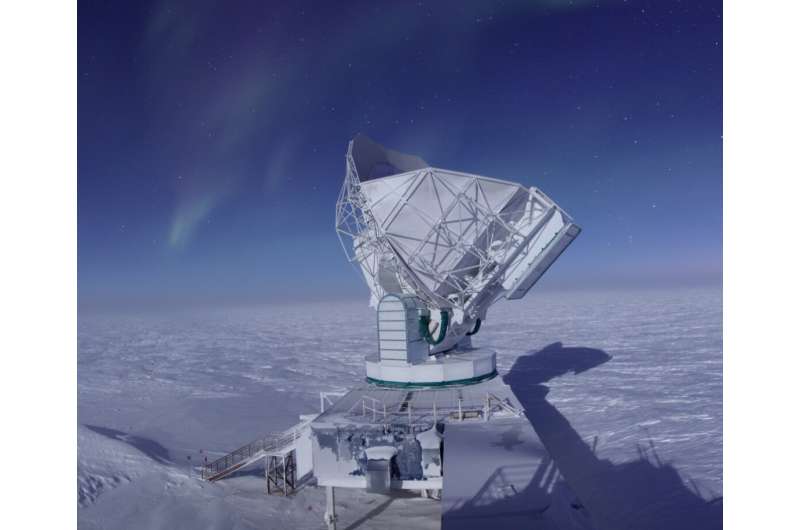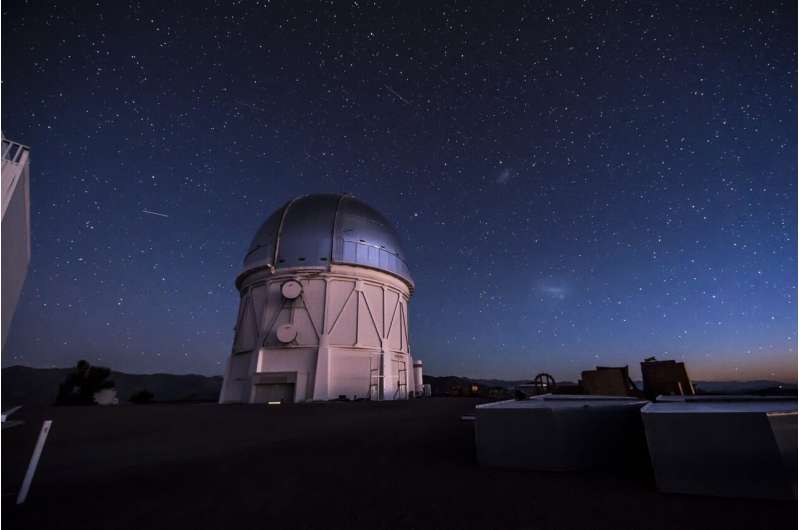Data from antipodal places: First use of CMB polarization to detect gravitational lensing from galaxy clusters

Galaxies. Amalgamations of stars, interstellar gas, dust, stellar debris and dark matter. They waltz through the cold universe, gravity nurturing their embrace. Occasionally, galaxies snowball into enormous galaxy clusters with masses averaging 100 trillion times that of our sun.
But this wasn't always the case.
In the infant universe, temperatures were so high that electrons and protons were too hot to form atoms. Everything was a hot, ionized gas, not unlike the surface of the sun.
Over the next 400,000 years, the universe expanded and cooled to around 3,000 degrees Celsius, about the temperature of an industrial furnace. At these temperatures, electrons and protons combined into hydrogen atoms and released photons in the process. This light, called the cosmic microwave background radiation, has been traveling through space ever since, a watermark of space and time.
Now, scientists have found new ways to tease information out of this inexhaustible time machine.
Constraining cosmology with CMB polarization
In a study published in Physical Review Letters, Fermilab and University of Chicago scientist Brad Benson and colleagues use the polarization, or orientation, of the cosmic microwave background to calculate the masses of enormous galaxy clusters using a new mathematical estimator. This is the first time that scientists have measured these masses using the polarization of the CMB and the novel estimation method.
"Making this estimate is important because most of the mass of galaxy clusters isn't even visible—it's dark matter, which does not emit light but interacts through gravity and makes up about 85% of the matter in our universe," Benson said.
The scientists' work may eventually shed light on dark matter, dark energy and cosmological parameters that reveal more about structure formation in the universe.

Destination: Antarctica
At Amundsen-Scott South Pole Station, support staff and scientists, nicknamed "beakers," work around the clock to manage the South Pole Telescope. It's not easy work. Amundsen-Scott South Pole Station is located at the southernmost place on Earth, where the average temperature is minus 47 degrees Celsius and the sun rises and sets only once a year. But the South Pole Telescope, a 10-meter telescope charged with observing the cosmic microwave background, known as the CMB, is more than capable of achieving its scientific goals in this harsh environment.
The camera on the South Pole Telescope measures minuscule fluctuations in the polarization of CMB light across the southern sky on the order of 1 part in 100 million on average, more sensitive than any other experiment to date.
"These minuscule variations can be affected by large objects such as galaxy clusters, which act as lenses that create distinctive distortions in our signal," Benson said.
The signal Benson and other scientists were looking for was a small-scale ripple around galaxy clusters—an effect called gravitational lensing. You can see a similar effect yourself by looking through the base of a clear wine glass behind which a candle is lit.
"If you look through the bottom of a wine glass base at a flame, you can see a ring of light. That's like the effect we would see from a strong gravitational lens," Benson said. "We are seeing a similar effect here, except the distortion is much weaker and the CMB light is spread out over a much larger area on the sky."
There was a problem, however. Scientists estimated they would need to look at around 17,000 galaxy clusters to measure the gravitational lensing effect from the CMB and estimate galaxy cluster masses with any certainty, even using their new mathematical estimator. While the South Pole Telescope provided deeper and more sensitive measurements of the CMB's polarization than ever before, its library of galaxy locations contained only about 1,000 galaxy clusters.
Destination: Chile
To identify more galaxy cluster locations from which to examine the gravitational lensing of CMB light around galaxy clusters, the scientists needed to travel roughly 6,000 kilometers north of the South Pole to the Atacama region of Chile, home to the Cerro Tololo Inter-American Observatory.

The Dark Energy Camera, mounted 2,200 meters above sea level on the 4-meter Blanco telescope at Cerro Tololo, is one of the largest digital cameras in the world. Its 520 megapixels see light from objects originating billions of light-years away and capture them in unprecedented quality. Most importantly, the camera captures the light and locations of the 17,000 galaxy clusters scientists needed to observe gravitational lensing of CMB light by galaxy clusters.
The scientists identified the locations of these clusters using three years' worth of data from the Fermilab-led Dark Energy Survey and then put these locations into a computer program that searched for evidence of gravitational lensing by the clusters in the polarization of the CMB. Once evidence was found, they could calculate the masses of the galaxy clusters themselves using their new mathematical estimator.
Destination: Unspoiled places
In the current study, the scientists found the average galaxy cluster mass to be around 100 trillion times the mass of our sun, an estimate that agrees with other methods. A substantial fraction of this mass is in the form of dark matter.
To probe deeper, the scientists plan to perform similar experiments using an upgraded South Pole Telescope camera, SPT-3G, installed in 2017, and a next-generation CMB experiment, CMB-S4, that will offer further improvements in sensitivity and more galaxy clusters to examine.
CMB-S4 will consist of dedicated telescopes equipped with highly sensitive superconducting cameras operating at the South Pole, the Chilean Atacama plateau and possibly northern-hemisphere sites, allowing researchers to constrain the parameters of inflation, dark energy and the number and masses of neutrinos, and even test general relativity on large scales.
Anthony Bourdain, a gifted storyteller and food writer, once called Antarctica "the last unspoiled place on Earth … where people come together to explore the art of pure science, looking for something called facts."
Scientists go far beyond Antarctica to another unspoiled place, the farthest reaches of our universe, to grapple with fundamental cosmological parameters and the behavior of structure in our universe.
More information: S. Raghunathan et al. Detection of CMB-Cluster Lensing using Polarization Data from SPTpol, Physical Review Letters (2019). DOI: 10.1103/PhysRevLett.123.181301
Journal information: Physical Review Letters
Provided by Fermi National Accelerator Laboratory




















